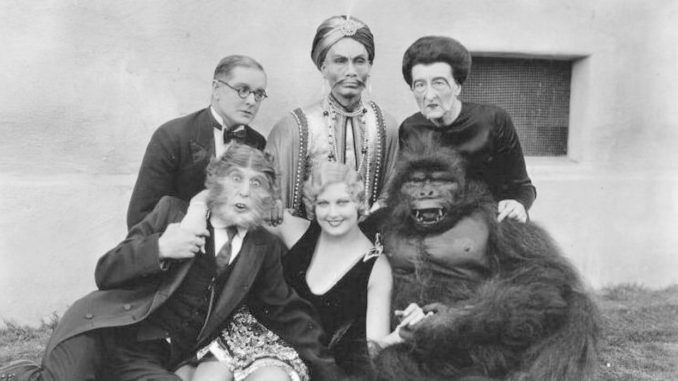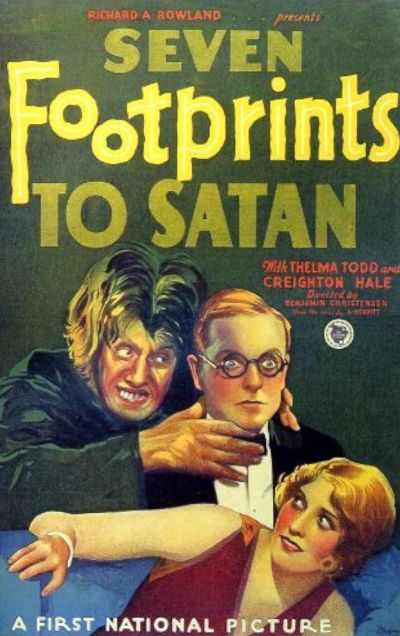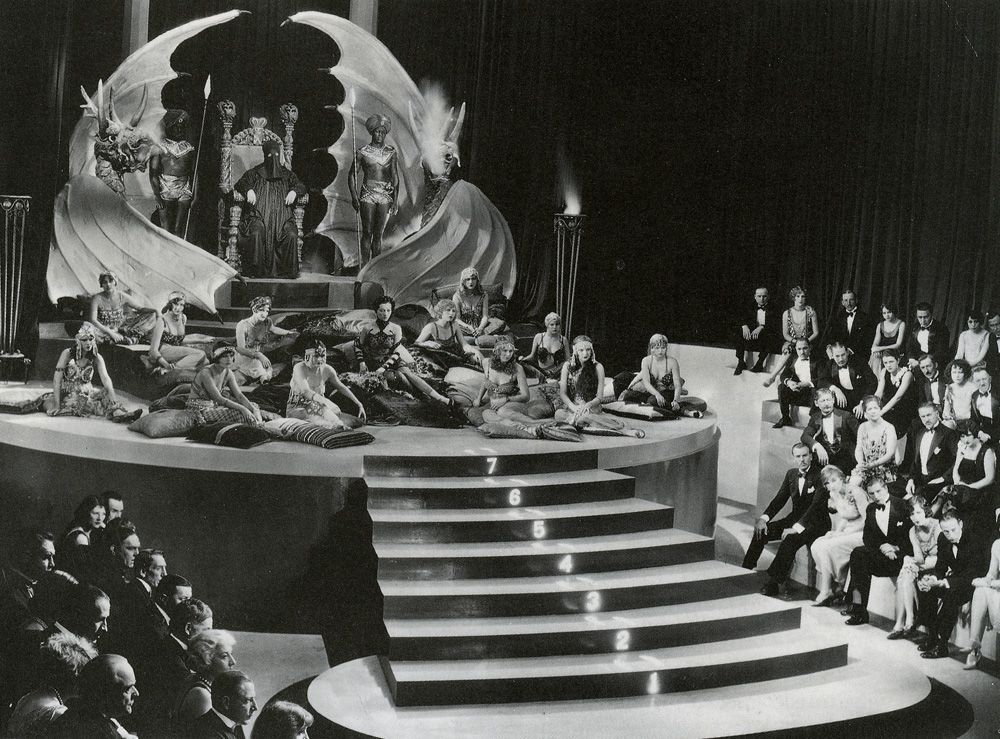
Rating: B-
Dir: Benjamin Christensen
Star: Creighton Hale, Thelma Todd, DeWitt Jennings, William V. Mong
We enter the silent era, though of course, the term “silent” is not accurate. Very few, if any, films were ever played out in silence. From the earliest days, there was musical accompaniment, and by the time this was released, more sophisticated methods were in place. In particular, audio for Footprints came on the Vitaphone system. The soundtrack was not part of the film, but came on separate records, which played along with the film when it was projected. Initially, these would be music and sound effects, but eventually dialogue would be part of the process too. The Jazz Singer used the Vitaphone process when it became the first true “talkie” in October 1927.
I considered a double-bill here, because this and The Last Performance each came in at the same score, 6.6, on the IMDb, and with virtually the same number of votes. At time of writing, Footprints has 527, while Performance has 526, so there was nothing to separate them. I was also tempted to stave off the terrors of silent cinema a little longer, perhaps with The Unholy Night – it does star Boris Karloff after all. Or if we did want to go silent, there was a familiar story, in The Hound of the Baskervilles, the last pre-sound adaptation of Sherlock Holmes. This year, the director of Footprints did House of Horror too, which sounded as if it could have been more appropriate.
 In the end though, I stuck to the rules, and after watching Footprints, I’m perfectly satisfied. Indeed, it’s more in the horror genre than yesterday’s entry, The Bat Whispers. This likely should not be a shock, since Christensen was one of the first horror auteurs. He is best known for Häxan (a.k.a Witchcraft Through the Ages), a semi-documentary in which the director played Satan. Variety called Häxan at the time, “absolutely unfit for public exhibition.” It still punched his ticket out of Denmark to Germany, from where MGM snapped him up. His time there ended unhappily: like Jacques Tourneur, he was fired from their production of The Mysterious Island, and went to work for Warner Brothers.
In the end though, I stuck to the rules, and after watching Footprints, I’m perfectly satisfied. Indeed, it’s more in the horror genre than yesterday’s entry, The Bat Whispers. This likely should not be a shock, since Christensen was one of the first horror auteurs. He is best known for Häxan (a.k.a Witchcraft Through the Ages), a semi-documentary in which the director played Satan. Variety called Häxan at the time, “absolutely unfit for public exhibition.” It still punched his ticket out of Denmark to Germany, from where MGM snapped him up. His time there ended unhappily: like Jacques Tourneur, he was fired from their production of The Mysterious Island, and went to work for Warner Brothers.
This was the second in a horror trilogy by Christensen, all starring Todd, and sits between The Haunted House and House of Horror. The others are lost, except for their Vitaphone recordings: Footprints only barely survived, in a ratty print intended for the Italian market. There’s some debate as to whether it included speech. The AFI catalog lists it as containing “Talking seq, sound effects, and music score,” and there may initially have been plans to include dialogue. It is particularly chatty in the early going. However, contemporary reports indicate it did not do so. It was based on a novel of the same name by Abraham Merritt, originally serialized by Argosy All-Story Weekly. In an early example of disgruntled authordom, Merritt bemoaned, “The only similarity between the book and the picture was the title.”
Jim Kirkham (Hale, the Harold Lloyd-looking mo’fo) has dreams of heading off to Africa with fiancée Eve Martin (Todd), to search for a lost civilization, much to the chagrin of his Uncle Joe (Jennings). But before he can achieve this ambition, he and Eve are kidnapped as they try to flee a robbery attempt. The young couple are brought to a mysterious house, inhabited by a veritable laundry-list of partying weirdos and degenerates – I can’t help feeling this was a significant influence on Rocky Horror. Jim tries to find a way to escape, but is confounded at every turn, eventually being brought in front of the house’s hooded master. Could it be… Satan? Our hero then has to negotiate the titular obstacle (below), which looks to have strayed in from a seventies game-show – only, with his very survival the prize, rather than a set of steak knives.
This is very much in the “waking nightmare” school of horror, in which things happen to Jim and Eve without rhyme or reason. Violence, or the threat of violence, is never far away, with people being shot or whipped, in a rather lascivious way the Hays Code would shortly forbid. Though to be honest, the film hardly seems to be trying to put the viewers off the idea of Satanism. Especially during the party sequence at the end, complete with dancing girls and alcoholic beverages (this being during the depths of Prohibition), it plays more like a recruitment video. The inhabitants (top) are a weird crew too. Satan’s vampy mistress; a man on crutches called The Spider; a werewolf-like creature referred to as Prof. Moriarty (!); an old witch; an Oriental gentleman with a fondness for banging a gong (for once, not yellowface, but Japanese actor Sôjin Kamiyama).
 There’s also a dwarf who pops out of cupboards, etc. played by Angelo Rossitto. He would go on to appear in Freaks and, fifty-six years after this, as half of Master Blaster in Mad Max: Beyond Thunderdome. He gets what may be the best line – well, intertitle – in silent movie history, telling Jim, “And watch out! Satan’s gorilla has escaped!” Oh, did I forget to mention that there’s a large primate roaming the premises? It’s an ape to which Jim is remarkably, and amusingly, oblivious. A pity it wasn’t followed by Lucifer’s aardvark, or Beelzebub’s narwhal: I can envisage an entire franchise based on such things: When Satanic Animals Attack. It sums up the lurid, faintly ludicrous, yet unquestionably entertaining nature of proceedings.
There’s also a dwarf who pops out of cupboards, etc. played by Angelo Rossitto. He would go on to appear in Freaks and, fifty-six years after this, as half of Master Blaster in Mad Max: Beyond Thunderdome. He gets what may be the best line – well, intertitle – in silent movie history, telling Jim, “And watch out! Satan’s gorilla has escaped!” Oh, did I forget to mention that there’s a large primate roaming the premises? It’s an ape to which Jim is remarkably, and amusingly, oblivious. A pity it wasn’t followed by Lucifer’s aardvark, or Beelzebub’s narwhal: I can envisage an entire franchise based on such things: When Satanic Animals Attack. It sums up the lurid, faintly ludicrous, yet unquestionably entertaining nature of proceedings.
Then there’s the ending, which is so abrupt as to feel like an entire reel remained lost: I’ve seen balloons take longer to pop. It would certainly benefit from explanation. Oh, I understand what happened: the why, however, is considerably harder to discern. Once you’ve caught your breath, you’ll probably feel there were less complex and expensive ways to achieve the same end. Admittedly, none are probably quite as much fun. If I had the resources, I’d probably do something similar, purely for my own amusement, and on a weekly basis. Hail Satan!
This article is part of our October 2025 feature, 31 Days of Vintage Horror.
